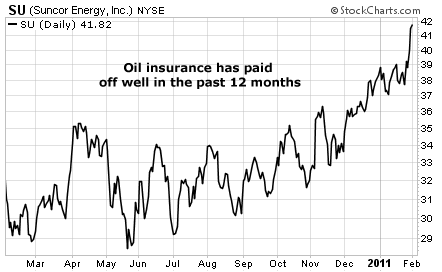| Home | About Us | Resources | Archive | Free Reports | Market Window |
A Unique Insurance Policy That Soars During Chaotic TimesBy
Wednesday, February 2, 2011
In early 2010, I introduced DailyWealth readers to the idea of "oil insurance."
You see, a majority of the world's largest oil deposits are located in the unstable Middle East. Any major disturbance there – like a shooting war in Iran – will cause the price of oil to skyrocket.
Since oil is a major cost for many different kinds of businesses, big price spikes can damage earnings and drag down an investment portfolio. Of course, they also cause the value of safe crude oil assets to skyrocket in value... assets like the Canadian oil sands.
That's how oil insurance works.
As I wrote in March, the Canadian tar sands are one of the world's greatest, safest oil deposits... second only to Saudi Arabia's reserves.
The latest estimates put the recoverable reserves here at 170 billion barrels. This huge store of oil is located in a safe, stable country... just a pipeline ride away from the world's most voracious consumer of oil. And while most Americans believe we are addicted to Middle Eastern oil, we actually import more oil from Canada than we do from Saudi Arabia.
So how has the "buy Canadian" oil insurance idea done? Take a look...
 This is a chart of Suncor Energy (NYSE: SU), a $65 billion world leader in tar-sand oil. When large investors want to make a pure play investment in the oil sands, they usually turn to Suncor. S&A Resource Report readers are up 43% on the stock in less than a year.
And while most of our gains are due to the uptrend in crude oil, our Suncor oil insurance policy jumped 7% in response to the uprising in Egypt. In other words, it behaved just as I expected.
As you can see, with the threat of political upheavals in Africa and the Middle East... and with the constant threat of the U.S. government debt leading to debasement of the U.S. dollar... it's essential to own assets that can actually thrive during periods of instability. That means owning plenty of gold and silver bullion, and stakes in vital oil and gas fields located in safe, stable countries.
Daniel Yergin got the name for his definitive history of the oil industry, The Prize, from a geologist's claim many years ago that Middle Eastern oil is "the single greatest prize in all history."
The Canadian tar sand deposit is the single greatest prize in North America. As you can see with Suncor's Egypt bounce, buying stocks operating in this area at the right price is – and will continue to be – one of the greatest forms of wealth insurance in the world.
Good investing,
Matt Badiali
Further Reading:
Last May, Matt wrote about an investment opportunity in one of Canada's biggest oil-sand deposits...
"Canada is a stable country. Also, there's no offshore drilling involved. And no terrorism. There's no need to ship the oil over thousands of miles of ocean," he wrote. "We know the oil is there, so there's no risky exploratory wells to be drilled."
One of his recommendations is up more than 30%. Learn more here: What You're Not Hearing About the Coming Offshore Drilling Ban.
And read Matt's essay about why Mexico could make Canadian oil even more valuable here: One of the World's Biggest Oil Producers Is Going Bust.
Market NotesTHE SLOW-MOTION DOLLAR CRISIS Our colleague Porter Stansberry hit a nerve with his controversial "End of America" video and talk of a currency crisis. Some folks wrote in to say it's crazy to claim the dollar is in a crisis right now.
The thing is, a currency crisis isn't something that suddenly hits the headlines, burns like a wildfire for a week, and then goes away. This sort of thing takes place over years and years...
To illustrate this phenomenon, we present the past 10 years of the U.S. Dollar Index. This index measures the dollar's value against a basket of major world paper currencies, like the euro, the Canadian dollar, and the Japanese yen. "Measure it against gold," some say... Last time we checked, folks aren't using gold to pay for things. They ARE using euros and Canadian dollars.
As you can see from the chart, the U.S. dollar has declined from its 2002 levels around 120 to its current level of 78. This is a 35% decrease in the value of the dollar over the past 10 years. This doesn't sound like a whopping fall on the surface, but realize it's an enormous loss in the purchasing value for a major currency... and it's why Porter says the dollar is in crisis.
|
In The Daily Crux
Recent Articles
|

